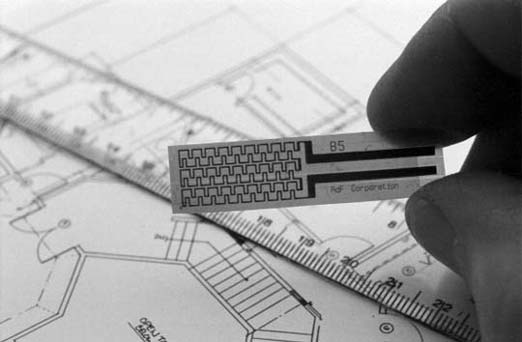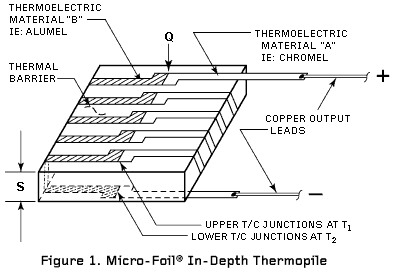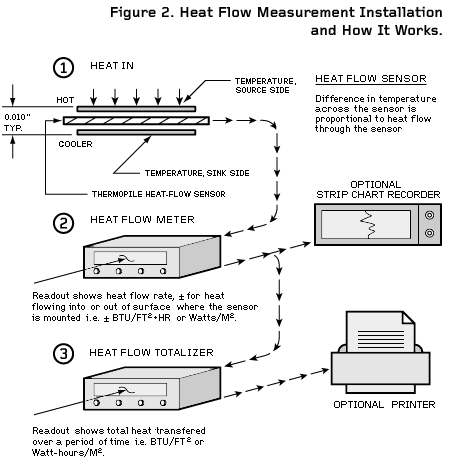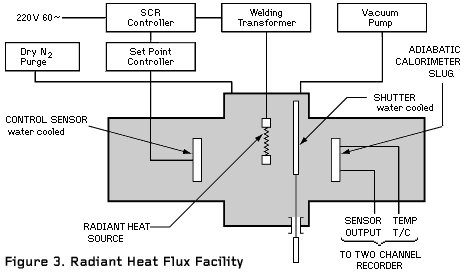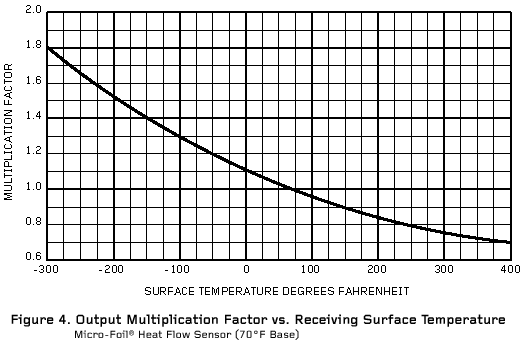|
Thermal Applications
Regardless of application, the primary function of the heat flow sensor is to obtain, as accurately as possible, a direct indication of the thermal energy transfer per unit time per unit area.
In the majority of the cases, this is expressed in units of Btu–ft–-2-h–1.
In all instances, the heat flow measured will be the thermal energy resulting from conductive heat transfer, or combinations of the following heat transfer modes.
Therefore, a discussion of each mode of heat transfer follows:
Conductive Heat Transfer
For measurement of conductive heat transfer, whether it be in insulating materials, existing structures or in complex laminated materials, the main consideration is that introduction of the heat flow sensor must have negligible effects on the process of heat conduction.
The best method for insuring intimate contact of the sensor with the test structure is: if it can be, in effect, cast within the material.
 Obviously, this results in a permanent installation and offers the best results. There will be many cases when the integral installation technique is not possible. In these cases, the sensor may be bonded to the inner or outer surface of the material or structure being tested.
This measurement technique is based on the fact that the thermal energy conducted through the material must also pass through the sensor before being dissipated into the surrounding environment. Obviously, this results in a permanent installation and offers the best results. There will be many cases when the integral installation technique is not possible. In these cases, the sensor may be bonded to the inner or outer surface of the material or structure being tested.
This measurement technique is based on the fact that the thermal energy conducted through the material must also pass through the sensor before being dissipated into the surrounding environment.
Convective Heat Transfer
Convective heat transfer is often closely associated with conductive heat transfer, since thermal energy conducted through enclosure walls may be transferred throughout the enclosed volume by convection.
Installation criteria for convective applications are therefore analogous to those of conductive applications where the sensor is attached to the inner or outer surfaces of the walls or structural materials.
One exception, although rarely occurring in everyday testing, is that in high velocity flow regions, the existing airflow may be laminar in nature.
Attachment of a sensor directly on a surface in laminar flow may result in disturbances of the flow, culminating in turbulent airflow; precautions should be taken to avoid this.
The usual technique is to recess the sensor an amount equal to its thickness, thus making the installation flush with the surrounding area.
 It should be emphasized that it is a rare case where high velocity airflow is found with regard to day–to–day testing.
Cases where this is a very important consideration are in applications such as the aerospace industry for airborne testing, wind tunnel testing, etc. It should be emphasized that it is a rare case where high velocity airflow is found with regard to day–to–day testing.
Cases where this is a very important consideration are in applications such as the aerospace industry for airborne testing, wind tunnel testing, etc. |
|
Radiant heat transfer
Measurement of absorbed radiant energy has only one prime requisite, which is: the sensor must have the same absorption or reflection qualities as the surface under test.
One fortunate factor in general testing is that since there is no perfect reflector or perfect absorber, most materials other than clean, smooth metals fall in an emissivity or absorptivity range of 0.4 to 0.8.
Typical Micro-Foil® heat flow sensors have a nominal emissivity of 0.7.
The standard sensor is a good match for a large number of materials.
 For more critical applications such as may be encountered when selecting coatings for walls, siding, etc., the sensor may be coated with the same material that the structure is coated with after bonding to the surface and thereby providing an identical emissivity and absorptivity as the area under test. For more critical applications such as may be encountered when selecting coatings for walls, siding, etc., the sensor may be coated with the same material that the structure is coated with after bonding to the surface and thereby providing an identical emissivity and absorptivity as the area under test.
 Best results are obtained with a black coating over everything because high absorbitivity is the most reproducible and stable. A permanent black surface is a new option on RdF Micro-Foil® heat flow sensors. Best results are obtained with a black coating over everything because high absorbitivity is the most reproducible and stable. A permanent black surface is a new option on RdF Micro-Foil® heat flow sensors.
Mounting Considerations
For accurate measurements, the chosen mounting method needs to provide a bond line free of visible voids. Thin bonds maximize respone. Continuous thin bonds are achieved by any of the following methods.
 The ease of installation of the Micro-Foil® sensors makes their applications almost unlimited. The thin and flexible sensors can be attached to flat or curved surfaces and may be permanently bonded in place with conventional adhesives or epoxies.
A convenient method for continued re-use at numerous locations is their installation using double adhesive-backed mylar tape. Upon installation, simply connect the leads to a millivoltmeter or similar readout device and a direct measurement of the surface heating or cooling rate in Btu–ft–-2-h–1 or equivalent units is provided. The ease of installation of the Micro-Foil® sensors makes their applications almost unlimited. The thin and flexible sensors can be attached to flat or curved surfaces and may be permanently bonded in place with conventional adhesives or epoxies.
A convenient method for continued re-use at numerous locations is their installation using double adhesive-backed mylar tape. Upon installation, simply connect the leads to a millivoltmeter or similar readout device and a direct measurement of the surface heating or cooling rate in Btu–ft–-2-h–1 or equivalent units is provided.
 For a single use temporary installation, Micro-Foil® heat flow sensors may be ordered with optional pressure sensitive adhesive (PSI) on the mounting surface. The adhesive layer is protected with a release sheet which is removed for use. For a single use temporary installation, Micro-Foil® heat flow sensors may be ordered with optional pressure sensitive adhesive (PSI) on the mounting surface. The adhesive layer is protected with a release sheet which is removed for use.
 There are other cases where heat flow data is required over a long or extended period. The best method of insuring stable installation for the entire period is to provide a permanent installation.
Each user may have his own preference as to an adhesive for mounting the sensor. A few recommendations which have been found satisfactory for past applications are as follows: for attachment to very smooth surfaces much as metallic, plastic or glass surfaces, cements such as Eastman No. 910 have been very satisfactory. For roughened surfaces such as walls, liquid epoxy, or a fast setting RTV are useable to temperatures as high as 250°F. This type of epoxy also has the advantage of curing at room temperature. For the few instances where a high temperature epoxy is desired, Emerson-Cuming No. 104 is useable to in excess of 450°F. However, the use of this adhesive requires an elevated temperature cure such as in an oven or use of radiant heat lamps. There are other cases where heat flow data is required over a long or extended period. The best method of insuring stable installation for the entire period is to provide a permanent installation.
Each user may have his own preference as to an adhesive for mounting the sensor. A few recommendations which have been found satisfactory for past applications are as follows: for attachment to very smooth surfaces much as metallic, plastic or glass surfaces, cements such as Eastman No. 910 have been very satisfactory. For roughened surfaces such as walls, liquid epoxy, or a fast setting RTV are useable to temperatures as high as 250°F. This type of epoxy also has the advantage of curing at room temperature. For the few instances where a high temperature epoxy is desired, Emerson-Cuming No. 104 is useable to in excess of 450°F. However, the use of this adhesive requires an elevated temperature cure such as in an oven or use of radiant heat lamps. |




